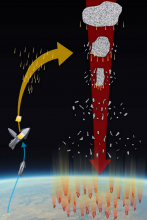Listen to today's episode of StarDate on the web the same day it airs in high-quality streaming audio without any extra ads or announcements. Choose a $8 one-month pass, or listen every day for a year for just $30.
You are here
Moon and Planets
The Moon and two bright planets form a beautiful triangle at dawn tomorrow. Brilliant Jupiter stands to the right of the Moon, with fainter orange Mars close below them.
The surfaces of the Moon and Mars have been sculpted in part by collisions with asteroids — big space rocks that orbit the Sun. The impacts have gouged craters. And on the Moon, they punched holes in the crust that allowed molten rock to bubble up from below, creating dark volcanic plains.
Jupiter gets hit by asteroids, too. In fact, because it’s a bigger target and has a stronger gravitational pull, it gets hit a lot. Over the last quarter of a century, in fact, astronomers have seen several asteroids and comets slam into the planet.
Jupiter doesn’t have a solid surface, though, so the impacts don’t leave permanent scars. Instead, they leave temporary markings — dark splotches in the planet’s upper atmosphere. They can persist for weeks or even months, and stretch across thousands of miles. Eventually, though, the atmosphere heals itself and the scars disappear.
Jupiter and Mars have received many asteroid visitors because they flank the asteroid belt — a wide band of debris left over from the birth of the planets. In fact, the gravity of nearby Jupiter kept the pieces from clumping together to make a planet.
Collisions between asteroids may send debris zipping out of the belt and toward the planets — creating potential hazards for these and other worlds.
Script by Damond Benningfield






